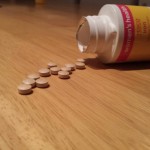 Iron is an important trace mineral required in humans for the correct function of the oxygen carrying haemoglobin and myoglobin molecules. Dietary iron is available as both haem and non-haem iron, and this can have a considerable influence on absorption. Haem iron is found in foods of animal origin that contain haemoglobin or myoglobin, and makes up around 60% of the total iron present in animal tissue. In contrast, non-haem iron is found mainly in plant tissues and is the primary plant storage form of iron. However, animal tissue also comprises around 40% of its iron as the non-haem form. Haem iron is more readily absorbed in humans compared to non-haem iron (here) and is therefore the prefered nutritional source. Haem iron is well absorbed because following hydrolysis in the stomach, the iron within the liberated porphyrin ring is in the ferrous (Fe2+) state. This remains soluble in the alkaline pH of the small intestine, where it is absorbed as absorbed as a metalloporphyrin ring.
Iron is an important trace mineral required in humans for the correct function of the oxygen carrying haemoglobin and myoglobin molecules. Dietary iron is available as both haem and non-haem iron, and this can have a considerable influence on absorption. Haem iron is found in foods of animal origin that contain haemoglobin or myoglobin, and makes up around 60% of the total iron present in animal tissue. In contrast, non-haem iron is found mainly in plant tissues and is the primary plant storage form of iron. However, animal tissue also comprises around 40% of its iron as the non-haem form. Haem iron is more readily absorbed in humans compared to non-haem iron (here) and is therefore the prefered nutritional source. Haem iron is well absorbed because following hydrolysis in the stomach, the iron within the liberated porphyrin ring is in the ferrous (Fe2+) state. This remains soluble in the alkaline pH of the small intestine, where it is absorbed as absorbed as a metalloporphyrin ring.
Once in the enterocytes the metalloporphyrin component of haem iron is hydrolysed to release iron. The reason that non-haem iron is relatively less well absorbed when compared to haem iron relates to it being liberated from tissues as ferric (Fe3+) rather than ferrous (Fe2+) iron. Ferrous iron (Fe2+) is more well absorbed that ferric iron (Fe3+) because it can pass through the brush border of the enterocytes much more freely before undergoing receptor mediated transport into the mucosa of the gut. As with haem iron, non-haem iron is hydrolysed from its plant components by the action of hydrochloric acid and pepsin in the stomach. This releases ferric iron (Fe3+) some of which is reduced to ferrous iron (Fe2+), both remaining soluble in the acid environment of the stomach. However, in the alkaline environment of the small intestine the ferric iron (Fe3+) can complex with other constituents of the gut to form ferric hydroxide [Fe(OH)3] which is relatively insoluble and therefore is less available for absorption.
Ascorbic acid can improve the absorption of non-haem iron because it can reduce ferric iron (Fe3+) to the more well absorbed ferrous (Fe2+) form. Further, some evidence shows that meat, poultry and fish can also increase the absorption of non-haem iron when consumed concomitantly. One line of evidence suggests that this results from the presence of thiol containing cysteine peptides released during the digestion of protein that can reduce ferric iron (Fe3+) to ferrous iron (Fe2+) in a similar way to ascorbic acid. For example, in one study1, researchers prepared digested protein and used it to assess the effects of the absorption of iron from maize in humans. One group consumed protein that was left untreated whereas another group consumed protein which had had the thio group oxidised. The results showed that absorption from the untreated protein was two-fold higher compared to the protein with oxidised thiol groups. Therefore the presence of cysteine containing peptides may explain why animal protein enhances non-haem iron absorption.
RdB
